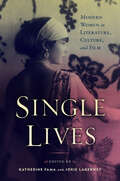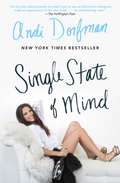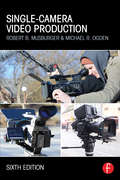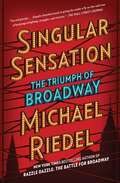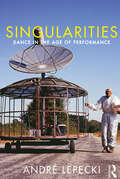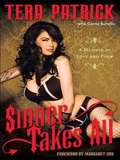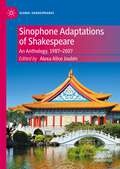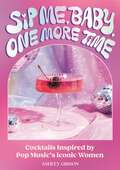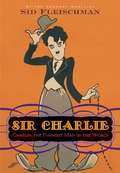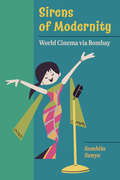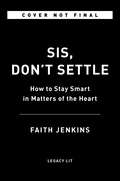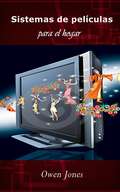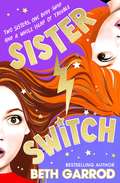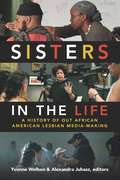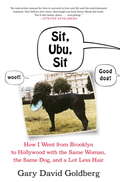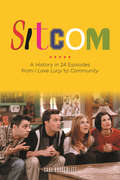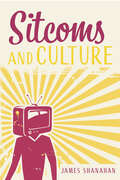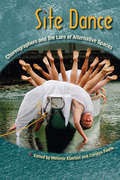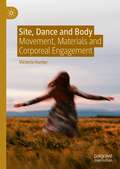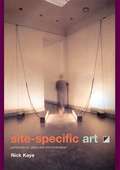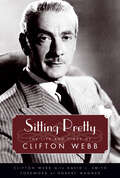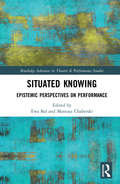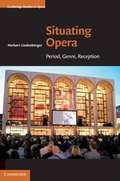- Table View
- List View
Single Lives: Modern Women in Literature, Culture, and Film
by Kristin Celello Pamela Robertson Wojcik Benjamin Kahan Emma Liggins Ann Mattis Jorie Lagerwey Katherine Fama Andreá N. Williams Jennifer S. Clark Elizabeth DeWolfe Martina Mastandrea Ursula KaniaSingle Lives is a collection of singleness studies essays from the interdisciplinary humanities that explores the last two hundred years of literature and popular media by, about, and for single women in the US and the UK. Independent women have always been a center around which social anxieties and excitement coalesced. Moving between the family home and domestic independence, between household and public labor, and between celibacy and a range of sexual relations, the single woman remains a literary and cultural focus, as she has been from the 19th to the 21st centuries. This collection offers readers the opportunity to uncover the social, political, economic, and cultural connections between the "singly blessed" women and "bachelor girls" of the 19th and early 20th century and "all the single ladies" of the 21st century. Essays read singleness across genre and field, offering new approaches to studying modern and contemporary single women in literature, film, and history. Authors engage scholarship from wide ranging fields of social history, women's studies, queer theory, and Black feminism. The collection reads familiar texts against the grain, rethinking archival resources, revisiting familiar figures, and exploring new sources: cookbooks, ephemera, personal documents, recovered film histories, and forms of domestic space and labor.This is a book for scholars of gender and sexuality, social history, feminist film and media scholars, and literary historians, and reflects the urgent contemporary interest in single women as a political, economic, and cultural force.
Single State of Mind
by Andi Dorfman<P>Andi Dorfman, breakout star of ABC’s The Bachelorette and New York Times bestselling author of It’s Not Okay, returns with this new collection of her adventures as a still-single gal surviving and thriving in New York City.Sharing moments like finding her first New York apartment (the front door broke so she had to use the fire escape), her first dates on “celebrity Tinder” and finally, watching her ex-fiancé propose to another woman on Bachelor in Paradise, Andi Dorfman doesn’t shy away from pulling back the curtain on the life of a reality star who’s returned to reality. <P>Dorfman’s supremely relatable personality has inspired incredible devotion from her fans, who follow her every move on social media. Filled with a mix of romantic mishaps, city adventures, and, of course, plenty of insider Bachelor details, Andi’s new book is Sex and the City for the reality TV generation. <P><b>A New York Times Bestseller</b>
Single-Camera Video Production (Media Manuals Ser.)
by Robert B. Musburger Michael R OgdenLearn everything you need to know about creating video using the single-camera format, from preproduction planning to setting up, rehearsing, shooting, striking, and pleasing your audience. Harness lighting, audio, editing, and aesthetic techniques that will enhance the quality of your video projects and keep your clients coming back for more. Simple, elegant, and easy to use, Single-Camera Video Production, Sixth Edition is a staple in any video artist’s library. Whether you’re just learning the basics of video production or you’re a veteran who needs a refresher, this book provides you with a toolkit for understanding and implementing single-camera workflows, as well as how to use the single-camera format to its best advantage by emphasizing the importance of goals, audience analysis, and technology. This new edition has been updated to include: Expanded sections on digital workflows, field and studio production, preproduction planning, audio, lighting, distribution, and nonlinear editing techniques Detailed gear lists covering the latest camera, recorder, audio, lighting, and stabilization equipment used in the industry today Fresh tips on creating video for your target audience and exhibition platform and shooting for the editing process Insider career advice, including tips on how to get an internship, interviewing, finding a job, and earning a promotion A companion website (www.focalpress.com/cw/musburger) with video examples of the techniques discussed in the book as well as evolving updates on key technological shifts
Singular Sensation: The Triumph of Broadway
by Michael Riedel&“Fun and gossipy.&” —The Wall Street Journal * &“A masterful history.&” —Publishers Weekly (starred review) * &“Engaging.&” —Newsweek A &“brisk, insightful, and deliciously detailed take&” (Kirkus Reviews) on a transformative decade on Broadway, featuring behind-the-scenes accounts of shows such as Rent, Angels in America, Chicago, The Lion King, and The Producers—shows that changed the history of the American theater. The 1990s was a decade of profound change on Broadway. At the dawn of the nineties, the British invasion of Broadway was in full swing, as musical spectacles like Les Miserables, Cats, and The Phantom of the Opera dominated the box office. But Andrew Lloyd Webber&’s Sunset Boulevard soon spelled the end of this era and ushered in a new wave of American musicals, beginning with the ascendance of an unlikely show by a struggling writer who reimagined Puccini&’s opera La Bohème as the smash Broadway show Rent. American musical comedy made its grand return, culminating in The Producers, while plays, always an endangered species on Broadway, staged a powerful comeback with Tony Kushner&’s Angels in America. A different breed of producers rose up to challenge the grip theater owners had long held on Broadway, and corporations began to see how much money could be made from live theater. And just as Broadway had clawed its way back into the mainstream of American popular culture, the September 11 attacks struck fear into the heart of Americans who thought Times Square might be the next target. But Broadway was back in business just two days later, buoyed by talented theater people intent on bringing New Yorkers together and supporting the economics of an injured city. &“Told with all the wit and style readers could wish for&” (Booklist) Michael Riedel presents the drama behind every mega-hit or shocking flop. From the bitter feuds to the surprising collaborations, all the intrigue of a revolutionary era in the Theater District is packed into Singular Sensation. Broadway has triumphs and disasters, but the show always goes on.
Singularities: Dance in the Age of Performance
by Andre LepeckiHow does the production of performance engage with the fundamental issues of our advanced neo-capitalist age? André Lepecki surveys a decade of experimental choreography to uncover the dual meaning of ‘performance’ in the twenty-first century: not just an aesthetic category, but a mode of political power. He demonstrates the enduring ability of performance to critique and subvert this power, examining this relationship through five ‘singularities’ in contemporary dance: thingness, animality, persistence, darkness, and solidity. Exploring the works of Mette Ingvartsen, Yvonne Rainer, Ralph Lemon, Jérôme Bel and others, Lepecki uses his concept of ‘singularity’—the resistance of categorization and aesthetic identification—to examine the function of dance and performance in political and artistic debate.
Sinner Takes All
by Tera Patrick Carrie BorzilloThe world's #1 porn star strips down about life, love, and everything in between. Tera Patrick wasn't always Tera Patrick. Once upon a time she was a gangly, teenaged bookworm named Linda Ann Hopkins, obsessed with serial killers and Marilyn Monroe and determined to make men all over the world one day desire her. And she succeeded: Today she sits atop the porn world and runs her own multimillion-dollar empire. Sinner Takes All is a sexy and deeply personal memoir in which Tera bares all about baring all. Tera discusses leaving home as a teen to work as an international fashion model, losing her virginity at age fourteen to a man twice her age, working as a nurse at a senior citizen's home, her on- and off-screen sexual escapades, and the emotional obstacles that she's had to overcome, including a strained relationship with her mother, deadbeat boyfriends, and a suicide attempt that led to a stint in a locked-down psych ward. An honest and naked look at a one-of-a-kind life, Sinner Takes All is a riveting memoir of the making of a modern sex goddess.
Sinophone Adaptations of Shakespeare: An Anthology, 1987-2007 (Global Shakespeares)
by Alexa Alice JoubinShakespeare’s tragedies have been performed in the Sinophone world for over two centuries. Hamlet, Macbeth, and King Lear are three of the most frequently adapted plays. They have been re-imagined as political theatre, comedic parody, Chinese opera, avant-garde theatre, and experimental theatre in Hong Kong, China, and Taiwan. This ground-breaking anthology features the first English translations of seven influential adaptations from 1987 to 2007 across a number of traditional and modern performance genres in Beijing, Shanghai, Hong Kong, and Taipei. Each of the book's three sections offers a pair of two contrasting versions of each tragedy - in two distinct genres - for comparative analysis. This anthology is an indispensable tool for the teaching and research of Sinophone theatre's engagement with Western classics in the late twentieth and early twenty-first centuries.
Sins of the Fathers (A Dark Shadows Novel)
by May Sutherlandautumn 1980: all seems well as the Collins family welcome David's fiancee, Lauren Chandler, into their midst. But when Lauren mysteriously disappears , it is only the first clue to unravelling a greater, more terrifying mystery confronting Barnabas and Julia - a mystery that spans two centuries and threatens the lives and security of everyone at Collinwood. It becomes evident that an unusual vampire has been let loose on the estate--one with the power to destroy everything Barnabas has so longed to have. Eventually, the fate of the entire family hangs in the balance as Julia follows a spirit's cryptic clues in a desperate effort to save them. Yet even that may not be enough, for Julia realizes that she has experienced some things before.
Sinéad O'Connor: and Other Conversations (The Last Interview Series)
by Kristin Hersh Melville HouseA significant collection of interviews with the defiant, controversial, and ground-breaking singer, songwriter, and activist throughout her turbulent career . . .&“It&’s not like I got up in the morning and said, &‘Okay, now let&’s start a new controversy&’.&” -- Sinéad O&’ConnorSinéad O'Connor&’s music — both in her songwriting and in her beautiful voice —addressed both emotional despair and incandescent joy with glorious ardor. But she may have been just as well known for her outspokenness. This collection of interviews covers the entire span of O'Connor's career, from the early days to her last interview. From giddy teenager to seasoned superstar, she speaks candidly about her meteoric rise to fame, and recounts what happened when she ripped up a photo of Pope John Paul II on live television in an act of protest. Unguarded and unpredictable, O'Connor was a woman who electrified the globe: imaginative, opinionated, and eloquent.
Sip Me, Baby, One More Time: Cocktails Inspired by Pop Music's Iconic Women
by Ashley GibsonMy thirstiness is killing me . . . As gorgeous as your favorite album art and as irresistible as a catchy hook, a collection of stunning (and stunningly easy) cocktail recipes based on pop songs by iconic women. With a great drink in your hand and the perfect song playing, you can transform any place into your own personal party. Pop music is unmatched when it comes to capturing a feeling, and this book is inspired by the great songs and women who define this genre, as well as some lesser-known artists whose music is as exciting as stumbling upon a new favorite liqueur that adds just the flavor you&’ve been missing.Sip Me, Baby, One More Time combines the art of cocktail making with the power of these artists to create an experience curated by emotion. Each chapter of this book is a journey through a playlist dedicated to a specific feeling—from coping with soul-crushing heartbreak to feeling like you want to hop on a table and dance it out—and is filled with easy to make, beautiful cocktails dedicated to tracks from top female artists.Featuring drinks inspired by songs from Britney Spears, Beyoncé, Taylor Swift, Rihanna, Ariana Grande, Lana Del Rey, BLACKPINK, The Spice Girls, Doja Cat, and many more.
Sir Charlie: Chaplin, the Funniest Man in the World
by Sid FleischmanThe story of Charlie Chaplin --the brightest Hollywood star, ablaze in movie astronomy, and by common consent, "the funniest man in the world."
Sirens of Modernity: World Cinema via Bombay (Cinema Cultures in Contact #3)
by Samhita SunyaA free open access ebook is available upon publication. Learn more at www.luminosoa.org. By the 1960s, Hindi-language films from Bombay were in high demand not only for domestic and diasporic audiences but also for sizable non-diasporic audiences across Eastern Europe, Central Asia, the Middle East, and the Indian Ocean world. Often confounding critics who painted the song-dance films as noisy and nonsensical. if not dangerously seductive and utterly vulgar, Bombay films attracted fervent worldwide viewers precisely for their elements of romance, music, and spectacle. In this richly documented history of Hindi cinema during the long 1960s, Samhita Sunya historicizes the emergence of world cinema as a category of cinematic diplomacy that formed in the crucible of the Cold War. Interwoven with this history is an account of the prolific transnational circuits of popular Hindi films alongside the efflorescence of European art cinema and Cold War–era forays of Hollywood abroad. By following archival leads and threads of argumentation within commercial Hindi films that seem to be odd cases—flops, remakes, low-budget comedies, and prestige productions—this book offers a novel map for excavating the historical and ethical stakes of world cinema and world-making via Bombay.
Sis, Don't Settle: How to Stay Smart in Matters of the Heart
by Faith JenkinsDATE SMARTER, MAKE BETTER DECISIONS IN LOVE, AND ACHIEVE THE RELATIONSHIP YOU DESERVE… IT ALL STARTS WITH NOT SETTLING! By day, Faith Jenkins is the host of Oxygen's Killer Relationship and former host of the nationally syndicated relationship show Divorce Court; by night, she&’s a happily married new mother who navigated these dating streets for years before learning how to attract the love of her dreams. When she turned 35 without a wedding ring in sight, like most women, she started getting tons of questions about not being married. But she made a decision: I. Will. Not. Settle. As an attorney and arbitrator, Faith has presided over hundreds of cases, and has helped couples avoid and resolve a wealth of drama. And she&’s seen it all! In Sis, Don&’t Settle, she&’s gathered an arsenal of love, wisdom and advice for women on how to play it smart. Modern culture would have women believe they can&’t have it all—and be smart, successful, strong women with authentic love to boot. Wrong. Told in her signature style—sometimes salty and sometimes sweet—Faith provides real solutions that will teach you how to thrive in relationships while avoiding common missteps and pitfalls. She delivers it straight, with no chaser, to show us how to level up, and reminds you that how you live single will set the tone for your success in relationships. Smart, illuminating, and, often laugh-out-loud funny, Sis, Don&’t Settle is the essential playbook that will help you build your confidence, generate better results in love, and land a high-value relationship once and for all. You&’ll find tips on topics like: Strong Independent Women…and the Men Who Love Them What&’s Worse than a Bad Relationship? Overextending Your Stay in One Becoming the Right Person to Attract the Right Person How to Release Trash Subconscious Beliefs that Keep You Settling And much more! Whether you&’re single, divorced, or in a situationship, Sis, Don&’t Settle reveals the direction and guidance you need to navigate love and take back your power.
Sistemas de películas: para el hogar (Como hacer... #20)
by Owen JonesSistemas de películas para el hogar Hola y gracias por comprar mi libro electrónico llamado 'Home Movie Systems'. Espero que encuentre la información útil, útil y rentable. La información en este libro electrónico sobre sistemas de películas caseras y temas relacionados es organizado en 17 capítulos de aproximadamente 500-600 palabras cada uno. Le ayudará a configurar un sistema de cine en casa, e incluso puede ayudarlo a aventurarse en una nueva carrera. Lo menos que hará es ahorrarle cientos de asesoramiento profesional. Como beneficio adicional, te estoy otorgando permiso para usar el contenido en tu propio sitio web o en tus propios blogs y boletines, aunque es mejor si los reescribes en tus propias palabras primero. También puede dividir el libro y revender los artículos. De hecho, el único derecho que no tiene es revender o regalar el libro tal como se le entregó. Si tiene algún comentario, por favor déjelo con la empresa que comprado este libro de. Puedes encontrar más libros como este allí también. Gracias de nuevo por comprar este libro electrónico, Respecto, Owen Jones
Sister Switch
by Beth GarrodA laugh-out-loud, modern take on the ever popular body-swap story from bestselling author Beth Garrod. Perfect for 9+ fans of Rachel Renée Russell's Dork Diaries and Alesha Dixon&’s Star Switch. Twelve-year-old Lily Mavers and her sister, Erin, do not get on. It doesn&’t help that Lily has nothing in common with her overachieving, Grade A student sister. But after an emergency trip to the oddly named Hairy Godmother salon, Lily and Erin leave with much more than a new look – they&’ve got a whole new life. Because the sisters have undergone a full-on body switch and they're about to find out that life in each other's shoes is much harder than it looks!Praise for Sister Switch: &‘World-class and whip-smart comedy magically mixed with a sweet message about sibling friendship. I absolutely loved it!&’ Sibéal Pounder, bestselling author of the Bad Mermaid series
Sisters in the Life: A History of Out African American Lesbian Media-Making (a Camera Obscura Book)
by Yvonne Welbon Alexandra JuhaszFrom experimental shorts and web series to Hollywood blockbusters and feminist porn, the work of African American lesbian filmmakers has made a powerful contribution to film history. But despite its importance, this work has gone largely unacknowledged by cinema historians and cultural critics. Assembling a range of interviews, essays, and conversations, Sisters in the Life tells a full story of African American lesbian media-making spanning three decades. In essays on filmmakers including Angela Robinson, Tina Mabry and Dee Rees; on the making of Cheryl Dunye's The Watermelon Woman (1996); and in interviews with Coquie Hughes, Pamela Jennings, and others, the contributors center the voices of black lesbian media makers while underscoring their artistic influence and reach as well as the communities that support them. Sisters in the Life marks a crucial first step in narrating the history and importance of these compelling yet unsung artists. Contributors. Jennifer DeVere Brody, Jennifer DeClue, Raul Ferrera-Balanquet, Alexis Pauline Gumbs, Thomas Allen Harris, Devorah Heitner, Pamela L. Jennings, Alexandra Juhasz, Kara Keeling, Candace Moore, Marlon Moore, Michelle Parkerson, Roya Rastegar, L. H. Stallings, Yvonne Welbon, Patricia White, Karin D. Wimbley
Sit, Ubu, Sit: How I Went from Brooklyn to Hollywood with the Same Woman, the Same Dog, and a Lot Less Hair
by Gary David GoldbergA sports-crazed kid from Bensonhurst, Brooklyn, Gary David Goldberg never imagined he'd end up in Hollywood, let alone make it big there. But as a twenty-five-year-old waiter in Greenwich Village he met Diana, the love of his life; followed her out to Northern California; then moved in and never moved out. He also, without realizing it, put himself on track to found UBU Productions (named after his beloved Labrador retriever) and become a successful creator of such family sitcoms asFamily Ties,Brooklyn Bridge, andSpin City. * InSit, Ubu, Sit, award-winning writer/producer Goldberg tells the mostly upbeat, sometimes difficult, and frequently hilarious tale of his improbable career and the people who have filled it. A love story and a rare behind-the-scenes look at the entertainment industry,Sit, Ubu, Sitproves that it is possible to be creative and successful while holding on to your integrity, your family, and your sense of humor. *with Bill Lawrence From the Hardcover edition.
Sitcom: A History in 24 Episodes from I Love Lucy to Community
by Saul AusterlitzA carefully curated tour through TV comedy series, this mixtape of fondly remembered shows surveys the genealogy of the form, the larger trends in its history, the best of what the genre has accomplished, and the most standard of its works. From I Love Lucy, The Phil Silvers Show, and M*A*S*H to Taxi, The Larry Sanders Show, and 30 Rock, this guide presents the sitcom as a capsule version of the 20th-century arts--realism giving way to modernism and then to postmodernism, all between the hours of 8 and 10pm on weeknights. Each chapter springs from an individual representative entity, including The Simpsons' "22 Short Films About Springfield," The Mary Tyler Moore Show's "Chuckles Bites the Dust," Seinfeld's "The Pitch," and Freaks and Geeks' "Dead Dogs and Gym Teachers," where Martin Starr's nerdy Bill takes comfort in--what else--the pleasures of laughing at TV.
Sitcoms and Culture (Comedy & Culture)
by James ShanahanDoes it matter what television we watch? Despite their stodgy reputation among many consumers of television, sitcoms, or situation comedies, have stuck around as a cornerstone of the television landscape.Sitcoms and Culture examines sitcoms as cultural artifacts ripe for exploration as they reflect the shifting landscapes of our society. From questions of social change to the portrayal of women and other racial, ethnic, and sexual minorities, sitcoms have evolved alongside the major social changes of the last half century. Using an interdisciplinary approach, author James Shanahan combines research on cultural indicators with an empirical methodology and cultural analysis to examine over 50 years of sitcoms to discern the reality of how these comedies have portrayed life to us across generations of television.Sitcoms and Culture helps us gain a deeper understanding of how sitcoms mirror and shape societal norms and of the pivotal role they have played in reflecting and influencing cultural trends.
Site Dance: Choreographers and the Lure of Alternative Spaces
by Melanie Kloetzel Carolyn PavlikIn recent years, site-specific dance has grown in popularity. In the wake of groundbreaking work by choreographers who left traditional performance spaces for other venues, more and more performances are cropping up on skyscrapers, in alleyways, on trains, on the decks of aircraft carriers, and in a myriad of other unexpected locations worldwide.In Site Dance, the first anthology to examine site-specific dance, editors Melanie Kloetzel and Carolyn Pavlik explore the work that choreographers create for nontraditional performance spaces and the thinking behind their creative choices. Combining interviews with and essays by some of the most prominent and influential practitioners of site dance, they look at the challenges and rewards of embracing alternative spaces. The close examinations of the work of artists like Meredith Monk, Joanna Haigood, Stephan Koplowitz, Heidi Duckler, Ann Carlson, and Eiko Otake provide important insights into why choreographers leave the theatre to embrace the challenges of unconventional venues.Site Dance also includes more than 80 photographs of site-specific performances, revealing how the arts, and movement in particular, can become part of and speak to our everyday lives. Celebrating the often unexpected beauty and juxtapositions created by site dance, the book is essential reading for anyone curious about the way that these choreographers are changing our experience of the world one step at a time.
Site, Dance and Body: Movement, Materials and Corporeal Engagement
by Victoria HunterHow does the moving, dancing body engage with the materials, textures, atmospheres, and affects of the sites through which we move and in which we live, work and play? How might embodied movement practice explore some of these relations and bring us closer to the complexities of sites and lived environments?This book brings together perspectives from site dance, phenomenology, and new materialism to explore and develop how ‘site-based body practice’ can be employed to explore synergies between material bodies and material sites. Employing practice-as-research strategies, scores, tasks and exercises the book presents a number of suggestions for engaging with sites through the moving body and offers critical reflection on the potential enmeshments and entanglements that emerge as a result. The theoretical discussions and practical explorations presented will appeal to researchers, movement practitioners, artists, academics and individuals interested in exploring their lived environments through the moving body and the entangled human-nonhuman relations that emerge as a result.
Site-Specific Art: Performance, Place and Documentation
by Nick KayeSite-Specific Art charts the development of an experimental art form in an experimental way. Nick Kaye traces the fascinating historical antecedents of today's installation and performance art, while also assembling a unique documentation of contemporary practice around the world. The book is divided into individual analyses of the themes of space, materials, site, and frames. These are interspersed by specially commissioned documentary artwork from some of the world's foremost practitioners and artists working today. This interweaving of critique and creativity has never been achieved on this scale before. Site-Specific Art investigates the relationship of architectural theory to an understanding of contemporary site related art and performance, and rigorously questions how such works can be documented. The artistic processes involved are demonstrated through entirely new primary articles from: * Meredith Monk * Station House Opera * Brith Gof * Forced Entertainment. This volume is an astonishing contribution to debates around experimental cross-arts practice.
Sitting Pretty: The Life and Times of Clifton Webb (Hollywood Legends Series)
by Clifton WebbMore than any other male movie star, the refined Clifton Webb (1889-1966) caused the moviegoing public to change its image of a leading man. In a day when leading men were supposed to be strong, virile, and brave, Clifton Webb projected an image of flip, acerbic arrogance. He was able to play everything from a decadent columnist (Laura) to a fertile father (Cheaper by the Dozen and The Remarkable Mr. Pennypacker), delivering lines in an urbanely clipped, acidly dry manner with impeccable timing. Long before his film career began, Webb was a child actor and later a suavely effete song-and-dance man in numerous Broadway musicals and revues. The turning point in his career came in 1941 when his good friend Noël Coward cast him in Blithe Spirit. Director Otto Preminger saw Webb's performance and cast him in Laura in 1944. Webb began to write his autobiography, but he said that he eventually had gotten “bogged down” in the process. However, he did complete six chapters and left a hefty collection of notes that he intended to use in the proposed book. His writing is as witty and sophisticated as his onscreen persona. Those six chapters, information and voluminous notes, and personal research by coauthor David L. Smith provide an intimate view of an amazingly talented man's life and times.
Situated Knowing: Epistemic Perspectives on Performance (Routledge Advances in Theatre & Performance Studies)
by Ewa Bal and Mateusz ChaberskiSituated Knowing aims to critically examine performance studies’ ideological and socio-political underpinnings while also challenging the Anglo-centrism of the discipline. This book reworks the concept of situated knowledges put forward over thirty years ago by American biologist and philosopher Donna Haraway in order to challenge the Enlightenment paradigm of objectivity in sciences by emphasising the role of the embodied and partial socio-cultural perspective of the scholar in the production of knowledge. Through carefully selected case studies of contemporary natural, cultural and technological performances, contributors to this volume show that the proposed approach requires new genealogies of traditional concepts, emerges from encounters with contemporary performative arts or contact zones and may potentially go beyond the human in order to include non-human ways of being in the world. It will be of great interest to students and scholars of performance studies, cultural studies, media studies and theatre studies.
Situating Opera: Period, Genre, Reception
by Herbert LindenbergerSetting opera within a variety of contexts - social, aesthetic, historical - Lindenberger illuminates a form that has persisted in recognizable shape for over four centuries. The study examines the social entanglements of opera, for example the relation of Mozart's Abduction from the Seraglio and Verdi's Il trovatore to its initial and later audiences. It shows how modernist opera rethought the nature of theatricality and often challenged its viewers by means of both musical and theatrical shock effects. Using recent experiments in neuroscience, the book demonstrates how different operatic forms developed at different periods to create new ways of exciting a public. Lindenberger considers selected moments of operatic history from Monteverdi's Orfeo to the present to study how the form has communicated with its diverse audiences. Of interest to scholars and operagoers alike, this book advocates and exemplifies opera studies as an active, emerging area of interdisciplinary study.
